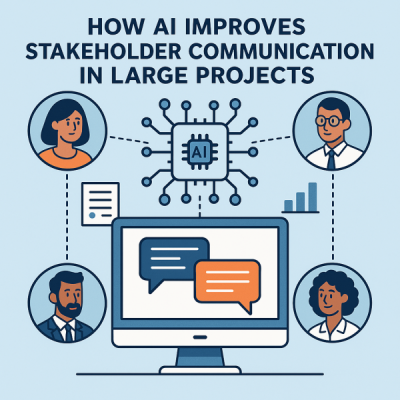
In large-scale architecture, engineering, and construction (AEC) projects, effective stakeholder communication is essential—but often difficult. With multiple parties involved, including developers, architects, engineers, contractors, regulators, and community representatives, keeping everyone informed, aligned, and engaged can be a monumental task.
Artificial intelligence (AI) is stepping in as a powerful tool to streamline, clarify, and enhance communication among stakeholders. From real-time data interpretation to automated reporting and natural language summarization, AI ensures that the right people receive the right information at the right time—without the noise.
In this article, we explore the many ways AI is transforming stakeholder communication in complex projects and why its use is becoming a strategic advantage in modern project management.
Large projects generate vast quantities of data—project updates, sensor readings, budgets, timelines, and more. AI tools can gather, process, and present this information in intuitive dashboards, making it easier for stakeholders to grasp what matters most.
Key capabilities:
Result:
Stakeholders get clearer, faster updates that focus on actionable insights, reducing misunderstandings and unnecessary meetings.
AI-driven chatbots can be deployed on project management platforms or communication tools to provide instant answers to common stakeholder questions.
Examples:
By handling routine queries 24/7, chatbots reduce the burden on human project managers and keep everyone more informed.
AI-powered sentiment analysis tools can scan communications—emails, meeting notes, and even survey responses—to gauge how stakeholders are feeling about project developments.
Use cases:
Benefit:
By understanding stakeholder sentiment proactively, project leaders can adjust communication approaches and mitigate potential issues early.
AI tools can now generate automated reports and meeting minutes using natural language processing (NLP) and speech-to-text technology.
How it works:
Impact:
Fewer things get lost in translation, and communication becomes consistent, fast, and traceable.
In international or public infrastructure projects, stakeholders may speak different languages or come from varying cultural contexts. AI-powered translation and language modeling tools help bridge these gaps.
Features:
Result:
Inclusive and accessible communication across global or diverse stakeholder groups.
Conclusion
AI is proving to be a vital enabler of efficient, transparent, and inclusive stakeholder communication in large projects. By automating routine reporting, personalizing insights, and interpreting feedback, AI ensures that everyone—from senior executives to community representatives—remains informed and aligned.
As projects become more complex and globally distributed, the ability to communicate clearly and intelligently becomes a competitive advantage. With AI in the communication loop, project leaders are better equipped to foster trust, improve outcomes, and deliver value across the board.
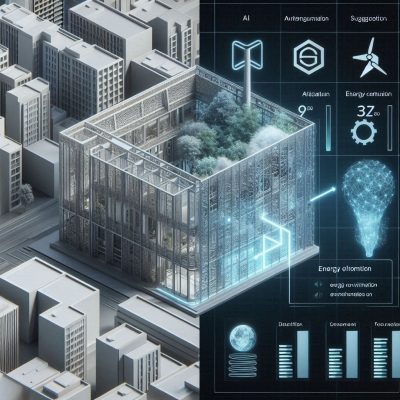
As the world accelerates its shift toward renewable energy, offshore wind farms have emerged as a key player in delivering large-scale, sustainable power. However, designing offshore wind installations presents unique challenges—from selecting optimal locations in harsh marine environments to maximizing energy output while minimizing environmental impact. This is where artificial intelligence (AI) steps in as a game-changer.
AI is revolutionizing how offshore wind farms are conceptualized, designed, and optimized. Through data analysis, simulation, and predictive modeling, AI tools enable engineers and planners to make smarter, faster, and more informed decisions that lead to more efficient and resilient wind energy systems.
In this article, we explore how AI is transforming the design process of offshore wind farms, from site selection and turbine layout to structural design and environmental assessment.
Choosing the right site is critical to the success of an offshore wind project. AI enhances this process by analyzing vast amounts of geospatial, meteorological, and oceanographic data to determine the most suitable locations.
How it works:
Impact:
By narrowing down ideal locations quickly and accurately, developers reduce project risk, cut feasibility study costs, and increase expected returns.
The placement of turbines significantly influences energy yield and maintenance efficiency. AI enables layout optimization by simulating different configurations and evaluating performance.
Key AI functions:
Result:
Improved layouts lead to higher overall energy production and lower operational costs.
AI-powered simulation tools assist engineers in designing foundation structures that withstand ocean forces such as waves, currents, and corrosion.
Applications:
Benefits:
This approach reduces the need for overly conservative (and costly) structural designs while improving long-term reliability and safety.
Sustainability is a top priority for offshore energy projects. AI supports environmental stewardship through real-time monitoring and impact assessments.
Examples:
Outcome:
AI ensures offshore wind farms operate in harmony with marine ecosystems and regulatory frameworks.
Integrating wind power into the electrical grid requires accurate forecasting of energy production. AI models help utilities plan for fluctuating supply from offshore farms.
Capabilities:
Result:
Enhanced grid stability and better alignment between energy production and demand.
Conclusion
AI is reshaping the offshore wind industry by making design and planning smarter, more precise, and more adaptive. From optimizing turbine layouts to minimizing environmental impact, AI enables developers and engineers to tackle the complexities of marine-based renewable energy with confidence.
As offshore wind expands globally, AI will continue to play a vital role in accelerating project timelines, reducing costs, and ensuring a more sustainable energy future. The intersection of intelligent systems and renewable infrastructure marks a critical step toward a decarbonized world.
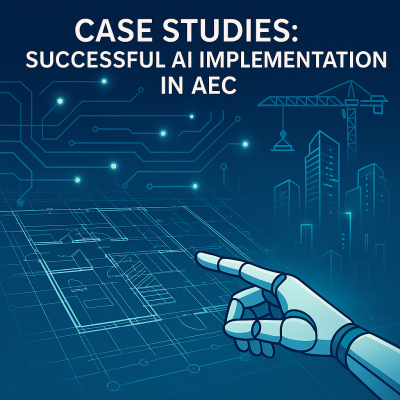
The Architecture, Engineering, and Construction (AEC) industry is undergoing a transformative shift as artificial intelligence (AI) becomes increasingly embedded in design, planning, and operations. While AI offers immense promise, its real-world applications tell the most compelling story. Across the globe, forward-thinking firms are implementing AI to streamline workflows, reduce costs, improve safety, and enhance sustainability.
In this article, we explore several real-world case studies that highlight successful AI implementation in AEC. These examples show how AI is not just theoretical hype—but a practical tool driving measurable results.
Case Study 1: AI for Risk Management at Skanska
Skanska, one of the world’s largest construction and development companies, implemented AI-driven analytics to improve safety and risk management across its job sites.
Challenge: Skanska needed a better way to predict and prevent on-site accidents, especially on large-scale infrastructure projects with high worker density.
Solution: By partnering with an AI analytics firm, Skanska deployed machine learning algorithms to analyze historical incident reports, weather data, project schedules, and sensor data from wearables.
Outcome:
Key Takeaway: AI can synthesize vast data sources to predict safety risks and improve job site health.
Case Study 2: Generative Design in Action — Gensler’s Office Layout Optimization
Global architecture firm Gensler used AI-powered generative design to plan a high-efficiency office for one of its tech clients.
Challenge: The client wanted an office that maximized team collaboration, access to daylight, and future flexibility.
Solution: Using Autodesk’s generative design engine, Gensler input spatial constraints, employee movement patterns, and daylight availability into the software. The AI generated hundreds of layout options optimized for collaboration and comfort.
Outcome:
Key Takeaway: Generative design offers rapid ideation and optimization based on real-world use patterns.
Case Study 3: Predictive Maintenance at Laing O’Rourke
UK-based contractor Laing O’Rourke deployed AI for predictive maintenance on heavy construction equipment to avoid costly downtime.
Challenge: The company experienced frequent unplanned equipment failures that delayed project timelines and increased maintenance costs.
Solution: By installing IoT sensors and using AI models to analyze performance data in real-time, Laing O’Rourke could predict when machines were likely to fail and service them preemptively.
Outcome:
Key Takeaway: AI enables smarter asset management, increasing reliability and reducing operational risk.
Case Study 4: BIM + AI for Clash Detection at Mortenson Construction
Mortenson Construction leveraged AI to enhance Building Information Modeling (BIM) clash detection and resolution.
Challenge: Traditional BIM coordination processes required manual clash detection that was time-consuming and error-prone.
Solution: Mortenson integrated AI with BIM tools to automatically detect, categorize, and prioritize design clashes between mechanical, structural, and architectural elements.
Outcome:
Key Takeaway: AI-enhanced BIM helps catch issues earlier, saving time and cost during construction.
Case Study 5: AI for Urban Planning in Singapore
Singapore’s Urban Redevelopment Authority (URA) has utilized AI to enhance urban planning decisions in one of the world’s densest cities.
Challenge: Managing land use, traffic, and environmental impact in a fast-growing metropolis requires rapid and informed decision-making.
Solution: The URA used machine learning models to analyze satellite imagery, demographic trends, and mobility data to simulate urban growth and test planning scenarios.
Outcome:
Key Takeaway: AI supports holistic urban planning by simulating future scenarios and guiding infrastructure investment.
Conclusion
From design studios to construction sites and urban planning agencies, AI is reshaping the AEC industry. These case studies highlight a common thread: AI works best when paired with domain expertise, high-quality data, and a willingness to adapt traditional workflows.
As more firms embrace AI, we’ll see broader adoption, better performance metrics, and even more innovative use cases emerge. For AEC professionals, the question is no longer “if” but “how” and “when” to integrate AI into their operations.
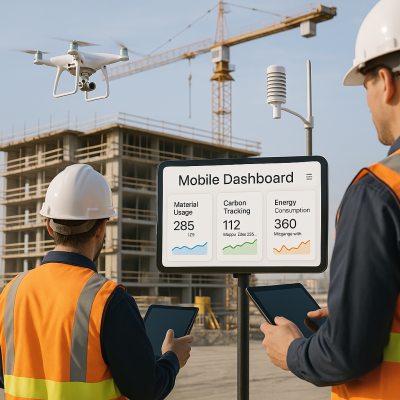
As the Architecture, Engineering, and Construction (AEC) industry grapples with the urgent need to reduce its environmental impact, Artificial Intelligence (AI) and Machine Learning (ML) are emerging as transformative technologies. From energy-efficient design to carbon tracking and adaptive infrastructure, these tools are redefining how professionals approach sustainability across the built environment.
This article explores how AI and ML are shaping the future of AEC in alignment with environmental sustainability, showcasing key innovations, emerging trends, and the opportunities that lie ahead.
The Environmental Imperative in AEC
The built environment contributes to nearly 40% of global carbon emissions. With urbanization accelerating and climate risks intensifying, the need for smart, sustainable solutions has never been more urgent. Traditional methods often lack the agility and data-driven insights required to address these challenges—this is where AI and ML step in.
How AI and ML Are Transforming Sustainability in AEC
Challenges Ahead
While the future is promising, several challenges must be addressed:
Collaboration among industry professionals, data scientists, policymakers, and communities is essential to overcome these barriers.
The Road Ahead: A Vision for 2030 and Beyond
Looking forward, we can expect:
As AI continues to evolve, its role will expand from optimization to innovation—helping humanity not just mitigate harm, but actively heal our relationship with the environment through smarter design and construction.
Conclusion
The fusion of AI, machine learning, and sustainability offers an unprecedented opportunity to reshape the built environment for the better. By embracing these technologies, AEC professionals can lead the charge toward a more resilient, equitable, and environmentally responsible future.

Artificial Intelligence (AI) is no longer a futuristic concept—it’s a present-day reality reshaping how architects and engineers design, build, and manage infrastructure. From automating routine tasks to optimizing complex simulations, AI empowers professionals to make better, faster, and more sustainable decisions. But to fully harness this power, engineers and architects must develop a new set of interdisciplinary skills.
This article outlines the essential skills needed to collaborate effectively with AI tools and technologies, helping industry professionals remain relevant and innovative in a rapidly evolving landscape.
At the heart of AI is data. Engineers and architects must understand how data is collected, processed, and used in AI applications. This includes:
Why it matters: AI systems can only make decisions based on the data they’re fed. Poor data quality leads to unreliable results, so professionals must know how to assess and improve their datasets.
While not everyone needs to be a software developer, understanding basic programming—especially in Python—opens doors to customizing AI workflows, tweaking scripts, and communicating with developers. Useful capabilities include:
Why it matters: Engineers and architects who can “speak AI” can collaborate more effectively with data scientists and tool developers, bridging the gap between technical teams and design practice.
The growing ecosystem of AI tools tailored to AEC (architecture, engineering, and construction) includes platforms for:
Professionals must stay up-to-date with relevant tools in their domain and learn how to evaluate them based on accuracy, usability, and transparency.
Why it matters: Tool literacy ensures that professionals can confidently integrate AI into their workflows and avoid over-reliance on black-box solutions.
AI can produce impressive results, but professionals must be prepared to critically evaluate those outputs. This includes:
Why it matters: AI should augment—not replace—human judgment. A strong ethical compass is essential to avoid blindly following AI-generated outputs that could be flawed or unjust.
AI often interacts with complex systems—whether that’s a building, a city, or an entire supply chain. Engineers and architects must understand:
Why it matters: A siloed understanding limits AI’s potential. Systems thinking helps professionals apply AI meaningfully across multiple project dimensions.
The best AI solutions come from interdisciplinary collaboration. Professionals must be able to:
Why it matters: Communication is key to ensuring that AI serves real-world project goals and that all stakeholders understand its benefits and limitations.
AI is evolving rapidly. Professionals who succeed will be those who continually upgrade their knowledge and adapt to emerging technologies. This means:
Why it matters: Staying relevant in an AI-enhanced industry requires more than mastering today’s tools—it demands curiosity, resilience, and a growth mindset.
Conclusion
As AI becomes a core part of design and engineering practice, professionals must move beyond traditional skill sets. From data fluency and programming to ethical reasoning and communication, a well-rounded toolkit will empower engineers and architects to not only use AI effectively—but to shape its future.
Whether you’re an early-career professional or a seasoned expert, investing in these skills will help you stay competitive and creatively empowered in a world where human and machine intelligence increasingly work hand in hand.
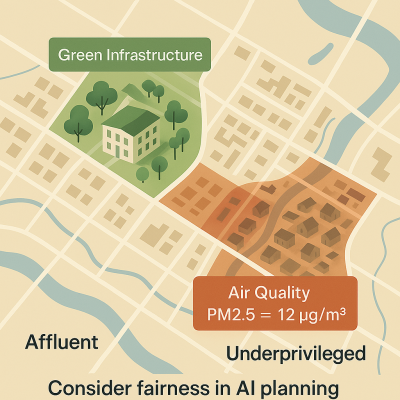
Artificial intelligence (AI) is transforming how we design buildings, manage infrastructure, and respond to environmental challenges. In architecture, AI aids generative design and space optimization. In engineering, it enhances simulation and predictive modeling. In environmental science, it enables smarter monitoring and resource management. However, with these advancements come pressing ethical questions.
As we delegate more decision-making power to algorithms, we must ask: Who is accountable? How do we prevent bias? Are these tools being used to benefit society—or merely to maximize profit? This article explores the ethical dimensions of AI integration in the fields of architecture, engineering, and environmental management, highlighting the responsibilities of professionals and developers alike.
AI systems often function as black boxes, making recommendations or decisions without clearly explaining how they were reached. In architecture and engineering, this opacity can have real consequences. For example:
Solution: Ethical AI use requires transparency. Designers and engineers must document how models are trained, what data was used, and how outputs are interpreted. Explainable AI (XAI) systems should be prioritized, allowing stakeholders to audit and question decisions.
AI models are only as unbiased as the data used to train them. If historical design or planning data reflects inequities—such as systemic neglect of low-income neighborhoods—AI could perpetuate these biases. In environmental applications, this can manifest as:
Solution: Ethical practice demands inclusive data sourcing, active bias auditing, and community involvement. AI should enhance environmental justice, not undermine it.
Smart buildings and infrastructure are increasingly equipped with AI-powered sensors, cameras, and monitoring tools. While these systems can improve efficiency and safety, they also raise concerns about surveillance and data privacy:
Solution: Ethical guidelines must prioritize informed consent, data anonymization, and clear data governance policies. Privacy should be built into the design of AI systems, not treated as an afterthought.
AI systems can automate many tasks traditionally performed by architects, engineers, and environmental scientists. While this boosts productivity, it also poses ethical questions about employment, skill development, and human dignity:
Solution: Instead of replacing humans, AI should augment human expertise. Ethical implementation involves retraining programs, equitable access to AI tools, and preserving opportunities for human creativity and judgment.
Ironically, while AI is often used to fight climate change, training large models consumes enormous energy. Engineering simulations, generative design, and smart city planning tools powered by AI all have a carbon cost.
Solution: Ethical AI use in sustainability must account for its own environmental impact. This includes:
When AI is used for projects in culturally diverse or indigenous communities—such as land-use planning or conservation—ethical risks increase. Imported models may not account for local knowledge systems, cultural values, or sovereignty.
Solution: Ethical AI deployment must include:
Conclusion
As AI becomes more embedded in architecture, engineering, and environmental decision-making, ethical considerations must evolve from side notes to central pillars. Professionals must advocate for responsible practices, developers must design transparent and inclusive systems, and regulators must establish clear frameworks for AI accountability.
Ultimately, ethics in AI is not just about avoiding harm—it’s about actively using technology to build a more just, equitable, and sustainable world.
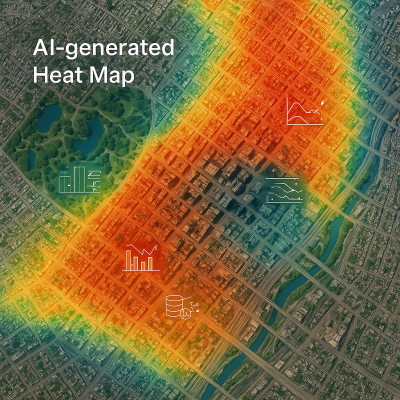
As cities continue to expand, the Urban Heat Island (UHI) effect—where urban areas experience significantly warmer temperatures than surrounding rural regions—poses a growing threat to public health, energy consumption, and environmental sustainability. This phenomenon is caused by dense concentrations of buildings, concrete surfaces, and human activity that absorb and re-emit heat more than natural landscapes.
Addressing the UHI effect has become a priority for urban planners, and artificial intelligence (AI) is emerging as a powerful ally in this mission. From predictive modeling and smart urban design to real-time monitoring and decision-making, AI technologies offer innovative solutions to cool our cities and create healthier, more livable environments.
In this article, we explore how AI is being leveraged to understand, manage, and mitigate urban heat islands.
Understanding Urban Heat Islands
Urban Heat Islands are exacerbated by:
UHI can increase local temperatures by 1 to 7°C (2 to 13°F), intensifying heatwaves, raising energy demand for cooling, and impacting vulnerable populations. AI helps tackle these issues by offering smarter, data-driven responses.
How AI Contributes to UHI Mitigation
AI algorithms, particularly machine learning models, can process satellite imagery, weather data, and urban infrastructure layouts to:
These insights inform targeted interventions, such as where to plant trees or deploy cooling infrastructure.
Using AI-driven simulations, urban planners can model various heat mitigation strategies and assess their impacts before implementation. For example:
Generative AI tools even assist architects in designing buildings and streetscapes that minimize heat absorption.
Smart sensors placed across cityscapes can feed real-time temperature, humidity, and air quality data into AI systems. These systems can:
AI-based dashboards and visualization tools help policymakers and citizens understand UHI risks and the benefits of mitigation strategies. Interactive platforms can:
AI can coordinate multiple urban systems—transportation, energy, water, and waste—in a cohesive heat mitigation strategy. For example:
Case Studies and Real-World Applications
Challenges and Considerations
The Road Ahead
AI’s potential in UHI mitigation is vast, but it must be implemented with inclusivity, sustainability, and ethical oversight. Interdisciplinary collaboration—combining AI experts, urban planners, environmental scientists, and community stakeholders—is key to developing robust and scalable solutions.
With ongoing advancements in AI, IoT, and climate modeling, future cities could become climate-resilient ecosystems that dynamically respond to environmental stressors and protect the well-being of their inhabitants.
Conclusion
Artificial intelligence is not a silver bullet, but when thoughtfully applied, it empowers cities to make smarter, faster, and more effective decisions in their fight against urban heat. By leveraging AI tools for monitoring, modeling, and urban design, we can not only cool our cities but also build more equitable, sustainable urban environments.
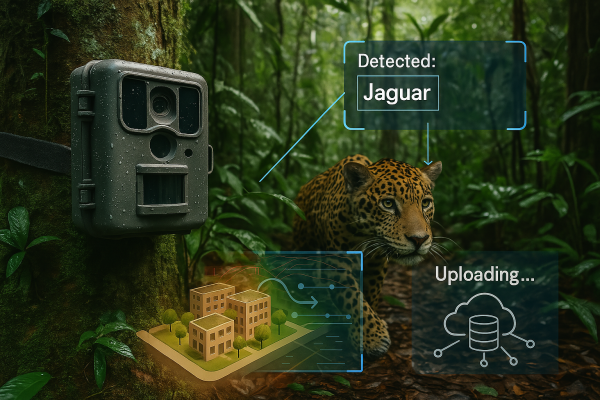
Biodiversity—the immense variety of life forms that populate our planet—is under threat. From habitat destruction and climate change to pollution and poaching, species and ecosystems are disappearing at an alarming rate. Traditional conservation efforts, while crucial, often struggle with limited resources and incomplete data.
Enter Artificial Intelligence (AI) and machine vision: a powerful technological duo capable of revolutionizing how we monitor, protect, and restore biodiversity. These technologies are providing scientists and conservationists with new tools to observe wildlife, map habitats, and predict threats with unprecedented accuracy and efficiency.
In this article, we explore how AI and machine vision are being deployed in biodiversity conservation and what the future holds for these innovations.
Understanding the Role of AI and Machine Vision
Together, they allow machines to recognize species, count populations, track animal movements, and even identify illegal activities such as deforestation or poaching.
Applications of AI and Machine Vision in Biodiversity Conservation
Using thousands of labeled images, machine vision models can be trained to identify plant and animal species with high accuracy. This technology is particularly useful in:
Platforms like Microsoft’s AI for Earth and iNaturalist employ these models to help both experts and citizen scientists catalog biodiversity efficiently.
Machine vision systems analyze satellite and drone imagery to detect changes in vegetation, forest cover, coral reefs, and wetlands. This allows conservationists to:
AI-enabled collar cameras and GPS trackers allow for real-time animal monitoring. Computer vision software interprets camera footage to recognize behaviors like feeding, mating, or distress, which can help tailor conservation efforts more precisely.
AI and vision systems are used in protected areas to scan live video feeds for suspicious human activity or vehicles. They can trigger alerts and deploy drones or rangers in response, significantly reducing poaching incidents.
Example: The nonprofit RESOLVE developed TrailGuard AI, a camera system with built-in AI that identifies human presence and alerts park rangers before poachers can act.
Although not visual, this machine-learning cousin of machine vision analyzes sounds from forests or oceans to detect species such as frogs, birds, or whales—often a better method for elusive or nocturnal species.
AI helps combine visual, acoustic, and environmental data to model biodiversity hotspots, forecast extinction risks, and recommend conservation actions. These insights can guide protected area design and resource allocation.
Benefits of AI and Machine Vision in Conservation
Challenges and Ethical Considerations
The Future of AI in Biodiversity Protection
As AI and machine vision technologies become more accessible and accurate, we can expect to see:
Conclusion
AI and machine vision are transforming biodiversity conservation from a reactive discipline into a proactive, data-driven science. By automating tedious tasks, providing real-time insights, and scaling global monitoring efforts, these technologies are essential allies in the fight to preserve our planet’s ecosystems and the countless species they support. While challenges remain, the integration of AI into conservation promises a smarter, faster, and more effective future for protecting life on Earth.

Water is one of the most vital natural resources on the planet, yet it is increasingly under pressure due to population growth, climate change, urbanization, and pollution. Managing water efficiently—across agriculture, urban utilities, and ecosystems—has become a pressing global challenge.
Enter Artificial Intelligence (AI). By leveraging machine learning, data analytics, and automation, AI offers transformative potential in how we monitor, allocate, and conserve water resources. This article explores how AI is being applied in water resource management and the tangible benefits it offers for sustainable development and environmental protection.
What Is Water Resource Management?
Water resource management involves planning, developing, and managing water resources to meet the needs of agriculture, industry, municipalities, and ecosystems. It includes:
AI’s ability to analyze vast datasets and make intelligent predictions makes it a powerful tool for tackling these tasks with greater accuracy and efficiency.
AI Applications in Water Resource Management
AI models can analyze historical consumption data, climate patterns, and demographic trends to forecast future water demand. This allows utilities and governments to optimize water distribution and storage systems in advance, reducing shortages or oversupply.
Agriculture consumes up to 70% of global freshwater. AI-powered irrigation systems use data from soil sensors, weather forecasts, and crop models to deliver water precisely when and where it’s needed. This reduces waste and boosts crop yields.
Example: AI algorithms in systems like IBM’s Watson Decision Platform for Agriculture optimize water schedules, reducing usage by 20–30%.
Machine learning models trained on hydrological, meteorological, and satellite data can detect early warning signs of floods and droughts. These systems help authorities prepare and respond more effectively, saving lives and property.
AI can process data from sensors that measure pH, turbidity, temperature, and contaminant levels in water sources. Anomalies or trends indicating pollution events (like oil spills or algal blooms) can be detected instantly, enabling faster interventions.
In smart cities, AI algorithms can identify unusual patterns in pressure and flow rates within water pipelines—often early indicators of leaks or pipe bursts. This prevents water loss and reduces infrastructure repair costs.
AI models help simulate the effects of land use changes, climate variability, and development projects on watersheds. This supports better policy decisions for long-term conservation and biodiversity protection.
AI is used to optimize water reservoir levels for hydropower plants, balancing energy production, flood control, and ecological needs. It takes into account river inflows, electricity demand, and environmental constraints.
Real-World Examples
Benefits of AI in Water Management
Challenges and Considerations
The Future of AI in Water Management
As climate change intensifies and population growth continues, the role of AI in water resource management will only become more critical. Future trends may include:
Conclusion
Artificial Intelligence is unlocking new frontiers in the sustainable and equitable management of water resources. By enabling smarter decision-making, predictive insights, and real-time responsiveness, AI tools are helping to secure water for people, ecosystems, and future generations. As we face mounting environmental challenges, embracing AI in water management is not just innovative—it’s essential.
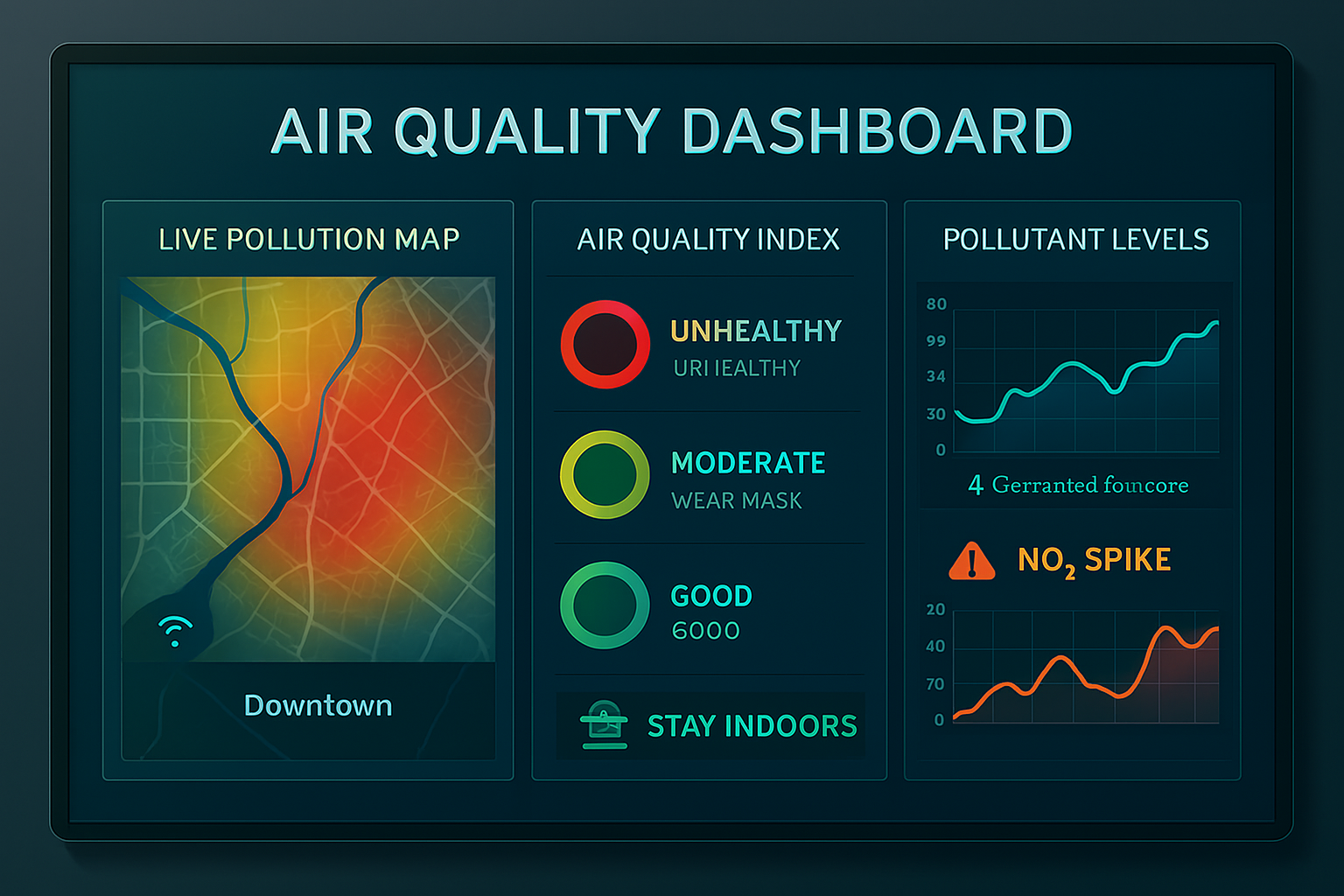
Air quality is a critical factor in public health, environmental sustainability, and climate change. With increasing industrialization, urbanization, and vehicle emissions, monitoring and managing air quality has become more important than ever. Traditional monitoring methods, while accurate, are often limited by cost, scale, and responsiveness.
Enter Artificial Intelligence (AI).
AI-powered tools are revolutionizing how we collect, analyze, and respond to air quality data. By integrating machine learning algorithms with sensor networks, satellite imagery, and meteorological data, AI offers real-time insights and predictive capabilities that were previously unattainable.
In this article, we explore how AI is transforming air quality monitoring, the technologies behind it, and the benefits it brings to cities, governments, and communities worldwide.
What Are AI-Powered Air Quality Monitoring Tools?
AI-powered air quality monitoring systems combine data science, sensors, and advanced analytics to measure and predict the concentration of pollutants in the atmosphere. These tools leverage:
Key Pollutants Monitored
AI tools are used to track and predict the behavior of key air pollutants, including:
Applications of AI in Air Quality Monitoring
Low-cost sensor networks combined with AI algorithms can create dynamic, street-level pollution maps. These tools analyze real-time data from hundreds of sensors, providing hyperlocal air quality information that helps residents make informed decisions about travel, outdoor activities, or ventilation at home.
AI models, such as neural networks and support vector machines, are trained on historical pollution data, weather patterns, traffic flows, and industrial activity to forecast future air quality conditions. These predictions can alert governments to upcoming pollution spikes and inform mitigation measures.
Machine learning algorithms can detect sudden spikes or unusual pollution events caused by wildfires, industrial leaks, or traffic congestion. These anomalies are flagged instantly, allowing for faster response and public communication.
AI-driven air quality systems are increasingly integrated into smart cities. They feed data to traffic management systems, regulate construction activity, and adjust public transit operations to reduce emissions during peak pollution periods.
Some wearable devices and mobile apps now use AI to provide personalized air quality alerts based on location, health conditions, and exposure history. These services are particularly useful for individuals with asthma, allergies, or cardiovascular issues.
Examples of AI Tools and Platforms
Benefits of AI in Air Quality Monitoring
Challenges and Considerations
The Road Ahead
As environmental regulations tighten and public demand for cleaner air grows, AI-powered tools will become a central component of air quality management. Future developments may include:
Conclusion
AI-powered tools are redefining how we monitor and respond to air pollution. With real-time data processing, predictive analytics, and wide-scale deployment, AI is not just enhancing air quality monitoring—it’s helping to create healthier, more sustainable communities. As technology advances, the synergy between artificial intelligence and environmental science will play a vital role in protecting our planet and our health.